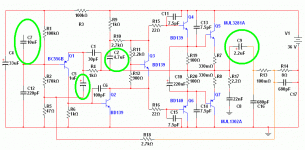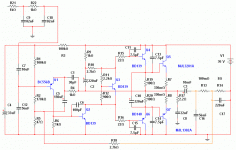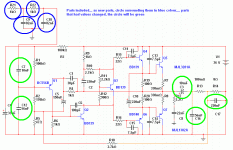tinitus said:Once heard that excessive solder will only raise impedance

Most probably, opposite . . .
The resistance, which is the major part of the ac impedance in this case, will be reduced quite much . . . You don't think so . . . ?
>
Babowana said:
. . . You don't think so . . . ?
><
No, I really dont
Considering that solder is mostly tin
Actually its commonly known good solder practise to use only small amount of solder, fore best result
Only the lines around the output needs to be big, and those skilled do that very differently
Better use wire
Fore the rest I would say quite the opposite, but as thin and direct as possible
I once saw an older PAudio built with thick solid copper fore connecting output transistors, and ground
As fore wire I do like tinned copper, but its very thin tinned
I never heard a good silvered cable, which makes one wonder about printboard with silvered copper lines
Those things do matter, if you want the best possible

Bah...theories!..... i think to build is what interests
If electrons have orange belt and are spinning clockwise or use pink shoes and spinning alike a dancer does not matter to me.
The time you loose thinking on that you could spend beeing creative and producing things for our communitty.
As you see...i do not like theories... they are alike wiskie...puts the guy drunk and without productive activity.
Be happy with theories my friends...i cannot be happy with them as i think it is alike religion...something have its function but use to be non very productive.
I have posted something about sensitivity adjustment into Dx Amplifier..but this is important to any kind of amplifiers.
I am inviting you to take a look at this adress.
This gonna be included into Greg Erskine home pages too.
http://www.diyaudio.com/forums/showthread.php?postid=1800059#post1800059
regards,
Carlos
If electrons have orange belt and are spinning clockwise or use pink shoes and spinning alike a dancer does not matter to me.
The time you loose thinking on that you could spend beeing creative and producing things for our communitty.
As you see...i do not like theories... they are alike wiskie...puts the guy drunk and without productive activity.
Be happy with theories my friends...i cannot be happy with them as i think it is alike religion...something have its function but use to be non very productive.
I have posted something about sensitivity adjustment into Dx Amplifier..but this is important to any kind of amplifiers.
I am inviting you to take a look at this adress.
This gonna be included into Greg Erskine home pages too.
http://www.diyaudio.com/forums/showthread.php?postid=1800059#post1800059
regards,
Carlos
Attachments
Nice board Megajocke.
I am afraid theories invade the thread... no practical things... ideas that does not produce boards or happyness..just intelectual duel and competition..pride and awfull human things appear during that procedure.
- First one say this is no good
- then come other and say i disagree
- Other enters and say that agree with the first one
- After that enters the fourth and say "I don't think so"
And them the process started.... other theorists invade to support one and other side and the mess starts.
I hope you are satisfied with those posts guys.
I am not
regards,
Carlos
I am afraid theories invade the thread... no practical things... ideas that does not produce boards or happyness..just intelectual duel and competition..pride and awfull human things appear during that procedure.
- First one say this is no good
- then come other and say i disagree
- Other enters and say that agree with the first one
- After that enters the fourth and say "I don't think so"
And them the process started.... other theorists invade to support one and other side and the mess starts.
I hope you are satisfied with those posts guys.
I am not
regards,
Carlos
Try to imagine dear folks...if this hawk starts to think too much
Try to imagine this hawk calculating the path of flight and angle of attack ... will not catch nothing .. there will be stand still... stopped thinking...hunting nothing...not a productive thing.
You see in our forum... the theorists are non productive..they offer nothing for us..build nothing...just talk and talk...or write and write..not even talk.
ahahahahah!
regards,
Carlos
Try to imagine this hawk calculating the path of flight and angle of attack ... will not catch nothing .. there will be stand still... stopped thinking...hunting nothing...not a productive thing.
You see in our forum... the theorists are non productive..they offer nothing for us..build nothing...just talk and talk...or write and write..not even talk.
ahahahahah!
regards,
Carlos
An externally hosted image should be here but it was not working when we last tested it.
DX-the solder lines can resist more than 40 amperes..so.... will never burn because supplies usually do not produce so big ammount of power, even during short circuit moments.
Right on , so for a supply that WILL , your way rules..
An externally hosted image should be here but it was not working when we last tested it.
Mix the lead and silver (plumbing solder) for even more current..
To keep the acid from making errors (pits/sloppy) , just paint
over the top of traces (toothpick/latex paint) Etch fast - no holes.
I use your method for all my "fat" boards .. thank you for
original idea.
OS
You are welcome Ostry!.... Babowana please stay
It is just a point of view...you are a friend alike all other guys from our communitty... alike a family we can have different points of views but we love one each other and we perceive all of us as very important..we are precious as we are the "crazy" fanatics of audio..people that will listen our conversations about the subject, our fellows, our buddies!
You are welcome Babowana, also Tinitus.. also wg_ski and also Megajocke..all precious rarities...folks that loves audio alike me!
I use to block when conversation goes to dangerous subjects as i have learned a lot in this forum..not only about electronics but also about people behavior...i have watched many threads be exploded, also watched some good guys, cooperative folks, living ridiculous moments.... this way i use to control things and to be hard to put deviations into the rails back again.
I am sorry if i was rude...please stay... each one of us is alike gold to me..believe me because things are this way deep in my heart!
regards,
Carlos
.......................................................................................................
Using higher power soldering iron, dear Ostry, you will have shinny tracks..with the soldering iron melting the solder perfectly even having some dissipation because the lines thickness and because the big ammount of solder.... also can be sanded to offer you a better look if you want.
Test it..you can produce short circuits and your track will not burn...as we use to build things at home, the workbench filled with small pieces of solder, leads cutted and plyers and all that stuff... shorts under boards are not difficult to happens...reason why i use to solder my components upper the board...everything has a reason...and that's one of the reasons i use boards this way..even beeing ugly they are safe when i do my mess into the workbench.
It is just a point of view...you are a friend alike all other guys from our communitty... alike a family we can have different points of views but we love one each other and we perceive all of us as very important..we are precious as we are the "crazy" fanatics of audio..people that will listen our conversations about the subject, our fellows, our buddies!
You are welcome Babowana, also Tinitus.. also wg_ski and also Megajocke..all precious rarities...folks that loves audio alike me!
I use to block when conversation goes to dangerous subjects as i have learned a lot in this forum..not only about electronics but also about people behavior...i have watched many threads be exploded, also watched some good guys, cooperative folks, living ridiculous moments.... this way i use to control things and to be hard to put deviations into the rails back again.
I am sorry if i was rude...please stay... each one of us is alike gold to me..believe me because things are this way deep in my heart!
regards,
Carlos
.......................................................................................................
Using higher power soldering iron, dear Ostry, you will have shinny tracks..with the soldering iron melting the solder perfectly even having some dissipation because the lines thickness and because the big ammount of solder.... also can be sanded to offer you a better look if you want.
Test it..you can produce short circuits and your track will not burn...as we use to build things at home, the workbench filled with small pieces of solder, leads cutted and plyers and all that stuff... shorts under boards are not difficult to happens...reason why i use to solder my components upper the board...everything has a reason...and that's one of the reasons i use boards this way..even beeing ugly they are safe when i do my mess into the workbench.
There are 2 brazilian folks building the Trust
one have finished, and will produce pictures..this one use to build all my amplifier models..he built the Dx Amplifier, the HRII, the Dx Turbo, the Precision 1 and the DHR Turbo....now the Trust was build too and he has appreciated a lot the sound.... he felt the sound having special presence, with shinny and strong trebles and wonderfull deep bass...soon he will provide pictures made using a cell phone.
The guy has a repair shop... televisions and DVDs are repaired there... when he has some time he use to build amplifiers for fun.
because of that, some details must be informed.
regards,
Carlos
one have finished, and will produce pictures..this one use to build all my amplifier models..he built the Dx Amplifier, the HRII, the Dx Turbo, the Precision 1 and the DHR Turbo....now the Trust was build too and he has appreciated a lot the sound.... he felt the sound having special presence, with shinny and strong trebles and wonderfull deep bass...soon he will provide pictures made using a cell phone.
The guy has a repair shop... televisions and DVDs are repaired there... when he has some time he use to build amplifiers for fun.
because of that, some details must be informed.
regards,
Carlos
The center frequency adjustment is a little bit boring
The output line has almost half from the supply voltage... this is adjusted by a trimpot... and the trimpot is installed into a series of big resistances ( R1, R2, Vr2 and R5 )....big values and having a filter condenser between them ( C4 ).
The current is small and the resistance is very big...also the filter condenser is very big... reason why the time constant is big too... condenser delays a lot to be charged with full voltage.... this disturbs the half voltage to the output line...turns the adjustment boring...you tweak and must wait things stabilize.
You can substitute all big condenser by 1uf or 2.2uf, this will make your adjustment faster...then, after adjustment, return the correct condensers in place... also the one at the feedback line does that.... also the bootstrapp condenser does that too.
Now the gain resistance..the one at the feedback line, it must be 1K if you assemble the 70V version (more than 100 watts at 4 ohms).... i am using 2K2 on my 40V amplifier and you can use also 3K if you perceive as needed to reduce input sensitivity.
Back some posts i have discussed sensitivity, i think into the Dx Amplifier thread but i have posted a link in this thread about this text..the sensitivity text..also will be posted at Greg Home pages.
R1, R2, Vr2 and R5 are the series resistances and C4 is the big condenser...yes..it can be reduced to half this value...was an overkill i think.... C4 can be made 1uf during adjustments and then, after that, return with the 33uf value, or 22uf value and even 10uf can be tried there (I have not tested..but i know if too much low you gonna have enormous hum into the output).
C5 is the feedback one... this one has big capacitance too..and also help to bother when you adjust the voltage into the output line...and this one must be half or a little bit higher than half the supply voltage.
The bootstrapp condenser also helps to turn this adjustment not kind.
All them can be replaced, by something small as 1uf while adjusting, and them return to the big ones.
Do not increase C11, C13, C14 and C24...maximum is 10pf and this has influences into the amplifier measurements into simulators...all parts was tweaked (exception was C4) for better performance into simulator THD measurements and fourier measurements.
Yes... a zener would be better there..but i have made this way..all stuff published this way..schematics and many foruns have this schematic as standard...so, i will change anything..because it is not an error..just a boring thing because my non very good decision to avoid a zener there... zener can allow me to use smaller resistances and will load very fast as will avoid the use of big condensers....but also some folks says it is noisy...that zener is that and those..well..there are folks against zener...others may prefer a CCS and this history will never finish... reason why it is there the way was made and will not be changed.
Do modifications under your own risk... the guaranteed schematic is the one offered...no modifications, upgrades and updates allowed.
regards,
Carlos
The output line has almost half from the supply voltage... this is adjusted by a trimpot... and the trimpot is installed into a series of big resistances ( R1, R2, Vr2 and R5 )....big values and having a filter condenser between them ( C4 ).
The current is small and the resistance is very big...also the filter condenser is very big... reason why the time constant is big too... condenser delays a lot to be charged with full voltage.... this disturbs the half voltage to the output line...turns the adjustment boring...you tweak and must wait things stabilize.
You can substitute all big condenser by 1uf or 2.2uf, this will make your adjustment faster...then, after adjustment, return the correct condensers in place... also the one at the feedback line does that.... also the bootstrapp condenser does that too.
Now the gain resistance..the one at the feedback line, it must be 1K if you assemble the 70V version (more than 100 watts at 4 ohms).... i am using 2K2 on my 40V amplifier and you can use also 3K if you perceive as needed to reduce input sensitivity.
Back some posts i have discussed sensitivity, i think into the Dx Amplifier thread but i have posted a link in this thread about this text..the sensitivity text..also will be posted at Greg Home pages.
R1, R2, Vr2 and R5 are the series resistances and C4 is the big condenser...yes..it can be reduced to half this value...was an overkill i think.... C4 can be made 1uf during adjustments and then, after that, return with the 33uf value, or 22uf value and even 10uf can be tried there (I have not tested..but i know if too much low you gonna have enormous hum into the output).
C5 is the feedback one... this one has big capacitance too..and also help to bother when you adjust the voltage into the output line...and this one must be half or a little bit higher than half the supply voltage.
The bootstrapp condenser also helps to turn this adjustment not kind.
All them can be replaced, by something small as 1uf while adjusting, and them return to the big ones.
Do not increase C11, C13, C14 and C24...maximum is 10pf and this has influences into the amplifier measurements into simulators...all parts was tweaked (exception was C4) for better performance into simulator THD measurements and fourier measurements.
Yes... a zener would be better there..but i have made this way..all stuff published this way..schematics and many foruns have this schematic as standard...so, i will change anything..because it is not an error..just a boring thing because my non very good decision to avoid a zener there... zener can allow me to use smaller resistances and will load very fast as will avoid the use of big condensers....but also some folks says it is noisy...that zener is that and those..well..there are folks against zener...others may prefer a CCS and this history will never finish... reason why it is there the way was made and will not be changed.
Do modifications under your own risk... the guaranteed schematic is the one offered...no modifications, upgrades and updates allowed.
regards,
Carlos
For those who multiamp their speakers, this project would make a very nice tweeter amp. Plenty of power. Just use the output cap as a pole in the crossover system, which will be required anyway. It will be small enough to use a film cap, for those who object to electrolytic coupling caps. Even the midrange crossover will often be small enough for a film cap.
Sheldon
Sheldon
Using this one as treble amplifier will be good
and will reduce costs.... just install a 10n condenser into the input and reduce the output condenser, the gain condenser and the bootstrapp condenser.
Only high frequencies of audio will cross de amplifier.... so you can plug it directly to the tweeter.
into 5 khz you have already a loss of 3 db into your amplification...of course bellow 5 kilohertz goes reducing till you will not have absolutelly none amplification.... from 8 kilohertz and up you will have full power to the treble.
Here the schematic with the modifications to produce a Trust Treble amplifier (TT, registered trademark..ahahahahah!)
regards,
Carlos
and will reduce costs.... just install a 10n condenser into the input and reduce the output condenser, the gain condenser and the bootstrapp condenser.
Only high frequencies of audio will cross de amplifier.... so you can plug it directly to the tweeter.
into 5 khz you have already a loss of 3 db into your amplification...of course bellow 5 kilohertz goes reducing till you will not have absolutelly none amplification.... from 8 kilohertz and up you will have full power to the treble.
Here the schematic with the modifications to produce a Trust Treble amplifier (TT, registered trademark..ahahahahah!)
regards,
Carlos
Attachments
High definition April slide movie into youtube
http://www.youtube.com/watch?v=_cBIbkbW_FE
I'll be honored with your visit.
regards,
Carlos
http://www.youtube.com/watch?v=_cBIbkbW_FE
I'll be honored with your visit.
regards,
Carlos
TB.... Trust Bass.... this one almost cut frequencies higher than 2 Kilohertz
Power into 2 Kilohertz is smaller than 1 watt.
High power only till 300 hertz... above this frequency you gonna have losses... into 400 hertz you have already 3 dB loss.
This is a subwoofer amplifier...output goes direct to the subwoofer driver.
Soon i will offer you suggestion to the midrange unit.
This way you will able to control deep basses separated to high bass and mids..and separated from the treble..so... three ranges to adjust in separate volume controls.
You know that limiting frequency the amplifier distorts less (Intermodulation)...also sending filtered signal to drivers they will work sligthly better....and you will be able to adjust three ranges.
regards,
Carlos
Power into 2 Kilohertz is smaller than 1 watt.
High power only till 300 hertz... above this frequency you gonna have losses... into 400 hertz you have already 3 dB loss.
This is a subwoofer amplifier...output goes direct to the subwoofer driver.
Soon i will offer you suggestion to the midrange unit.
This way you will able to control deep basses separated to high bass and mids..and separated from the treble..so... three ranges to adjust in separate volume controls.
You know that limiting frequency the amplifier distorts less (Intermodulation)...also sending filtered signal to drivers they will work sligthly better....and you will be able to adjust three ranges.
regards,
Carlos
Attachments
Added parts in blue...new value to previously existent parts
have receive green circle surrounding them.
regards,
Carlos
.....................................................................
TT = Trust Treble, was only simulated, not tested real life
TB = Trust Bass, was only simulated, not tested real life
TM = Trust Mids...not created yet.
......................................................................
have receive green circle surrounding them.
regards,
Carlos
.....................................................................
TT = Trust Treble, was only simulated, not tested real life
TB = Trust Bass, was only simulated, not tested real life
TM = Trust Mids...not created yet.
......................................................................
Attachments
Member
Joined 2009
Paid Member
- Status
- This old topic is closed. If you want to reopen this topic, contact a moderator using the "Report Post" button.
- Home
- Amplifiers
- Solid State
- Trust, the most delicious Dx Amplifier





